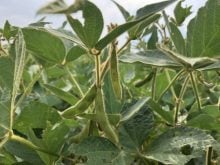GLEN BAIN, Sask. – Farmers in southwestern Saskatchewan whose fields are overrun by ground squirrels say the loss of a popular gopher poison is costing them time and money and forcing them to use products that are more dangerous and less effective.
BJ Haubrich, a farmer and agronomist from Hazenmore, Sask., said the loss of Rozol Plus sideswiped farmers’ efforts to get gopher populations under control.
Rozol Plus, an anticoagulant, was easily the most popular gopher control product among farmers in the Hazenmore area.
Haubrich said producers who used the poison achieved effective control in a matter of weeks, converting barren, pock-marked fields into productive farmland.
Read Also

Fall rye hits record high in Manitoba
Winter cereals 2025: More Manitoba fields grew fall rye in 2025 than ever before, but winter wheat slipped and, while spring stand survival was good, drought took its toll
The unregistered product has been forced off the market by the Pest Management Regulatory Agency (PMRA).
“If Rozol Plus was still available, fields in this area would have been cleaned up completely,” Haubrich said. “(A couple more years) and gopher control would have been complete. The problem would have been eliminated.”
Less effective
Producers in southwestern Saskatchewan have access to other poisons including liquid strychnine and phostoxin but Haubrich said those products are more dangerous to handle than Rozol Plus and are less palatable to rodents.
Rozol Plus can be applied with bare hands and poses minimal risk to farmers who apply it on their fields.
By comparison, strychnine and phostoxin are highly toxic and can have a serious impact on the health of users if ingested or inhaled.
“When you look at a product like phostoxin, this is a deadly nerve gas. It can knock you down for a long time if you’re not careful and this is what a lot of farmers are resorting to, now that Rozol Plus isn’t available,” he said.
“I think the PMRA, by taking Rozol Plus off the market, has put farmers in danger.”
Farmers throughout southwestern Saskatchewan say gophers were attracted to Rozol Plus because it had a sweet, flavourful attractant that was added to the bait.
An unflavoured, less palatable version of Rozol is still available.
Producers are now buying unflavored liquid Rozol, applying it to grain-based baits and adding their own attractants such as vanilla extract, icing sugar, anise and table salt.
Some farmers are mixing the ingredients in concrete mixers, which takes extra time and effort during the busiest time of year.
According to Haubrich, crop losses caused by gophers can range from a few percent in lightly populated areas up to 100 percent in severely infested fields.
To achieve good control, some producers must set up as many as 160 bait stations on a single quarter section.
The stations must be placed in the fields, refilled with poison once or twice over several weeks and retrieved before a crop can be seeded.
Larger farmers can easily spend as many as 20 hours a week in spring preparing, setting out and maintaining the bait stations, Haubrich said.
“It can be very time consuming, especially when you’re trying to get a crop seeded.
“The guy from Alberta who was making Rozol Plus saved farmers in this area a lot of time and money.
“When they took that away, they created a lot of headaches.”















